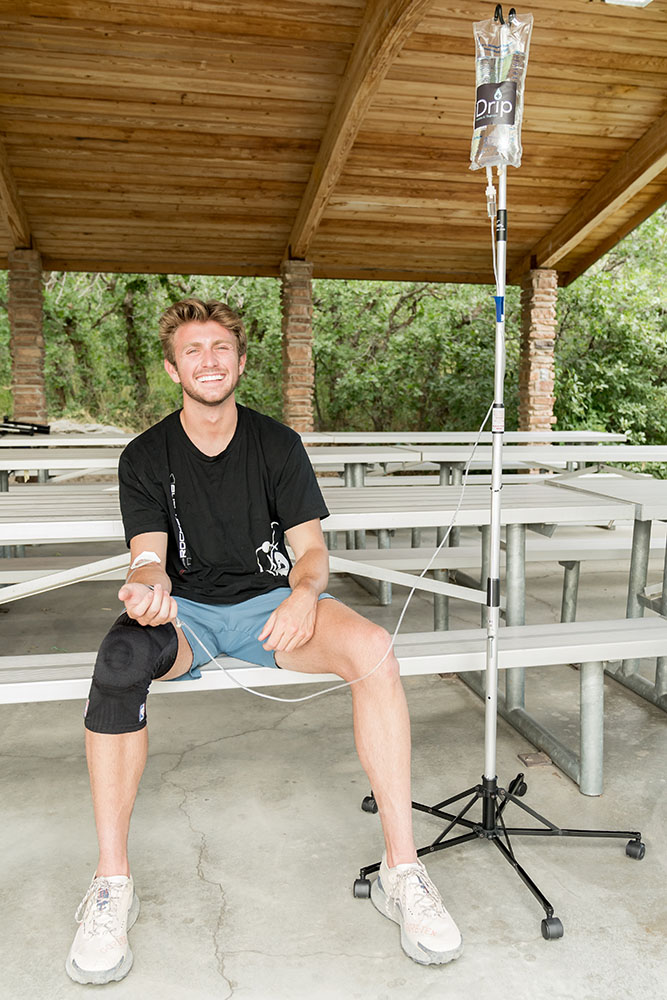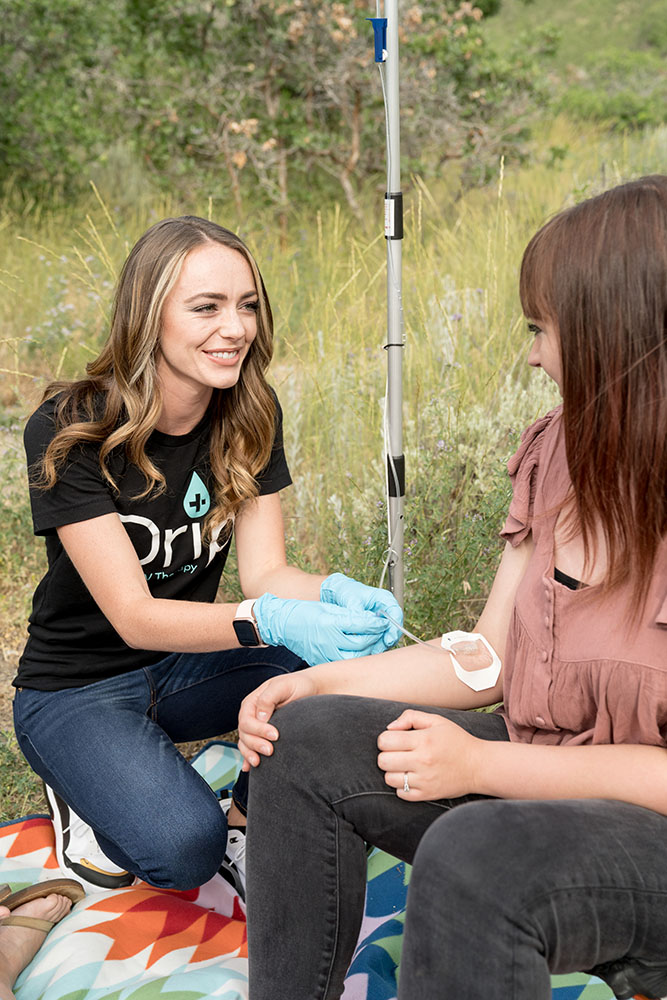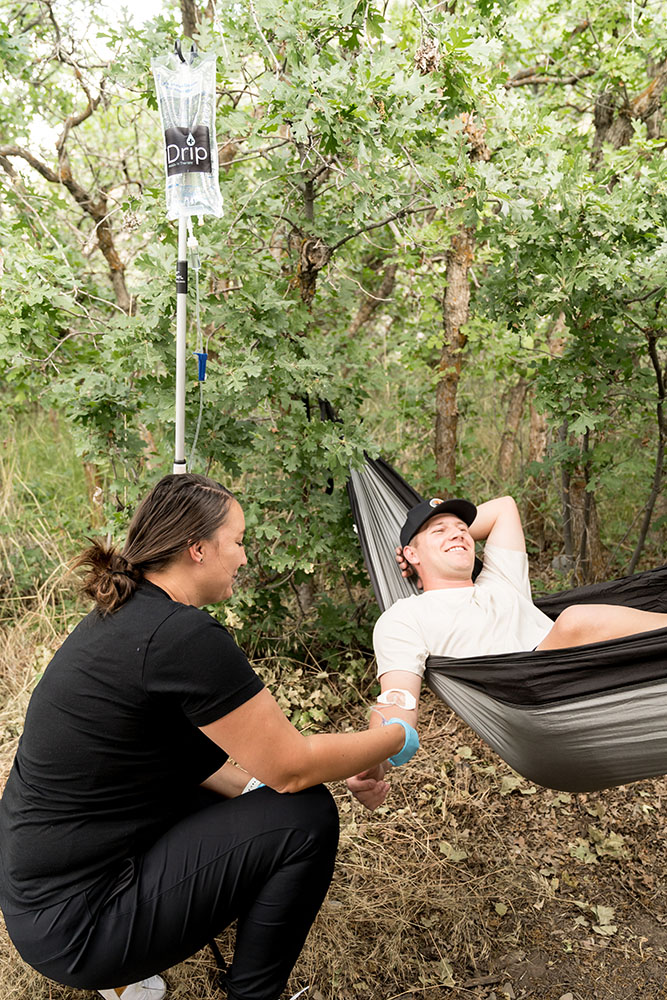Utah and Idaho, known for their stunning mountainous landscapes and outdoor adventures, attract nature enthusiasts and hikers from around the world. While the mountains are perfect for skiers, snowboarders, and hikers, altitude sickness can put a damper on your Utah or Idaho visit.
IV fluids can be a huge help for treating altitude sickness. If you’re planning a trip to the picturesque mountains of Utah or Idaho, understanding what IV therapy for altitude sickness will help you ensure that your trip is a fun a healthy experience. In this blog post, we’ll explore how IV therapy can be a game-changer when it comes to combating altitude sickness in these Utah, Idaho, or wherever else you may be at a higher altitude.

When you venture into the high-altitude regions of Utah and Idaho, it’s a good idea to be aware of the symptoms of altitude sickness. These symptoms can vary in severity and typically manifest within the first 6 to 12 hours after arrival at higher elevations. Here are the common signs to watch for:
It’s crucial to listen to your body and recognize these symptoms promptly. If you experience severe symptoms such as confusion, chest pain, or difficulty walking, seek immediate medical attention as these could be signs of a more serious condition like high-altitude cerebral edema (HACE) or high-altitude pulmonary edema (HAPE). However, for milder cases of altitude sickness, IV therapy can offer a quick and effective solution to your altitude sickness.
If you opt for an alternative to IV therapy for altitude sickness, you can try ibuprofen or other medication to treat symptoms. Ensure that you stay hydrated and give 24-48 hours before participating in other high altitude activities such as hiking, climbing, snowboarding, or skiing.

Altitude sickness can affect anyone, regardless of age, gender, or physical fitness level. However, some factors increase your susceptibility to this condition when visiting the elevated regions of Utah and Idaho. Understanding these risk factors can help you take preventive measures and be better prepared for your higher altitudes.
Rapid Ascent: Ascending to higher altitudes too quickly is a primary risk factor. Your body needs time to acclimatize to changes in elevation. Avoid rapid ascents and allow your body to adjust gradually by spending a day or two at a moderate altitude before reaching higher elevations.
High Altitude: The risk of altitude sickness increases significantly at altitudes above 8,000 feet (2,500 meters). Many popular destinations in Utah and Idaho, such as ski resorts, national parks, and mountain towns, exceed this altitude threshold. Be prepared with plan for IV therapy for altitude sickness in case you start noticing symptoms.
Lack of Acclimatization: If you’re visiting from a lower elevation area and haven’t had time to acclimatize, you’re more likely to experience altitude sickness. Acclimatization involves allowing your body to adapt to the reduced oxygen levels at higher altitudes.
Dehydration: Dehydration can exacerbate altitude sickness symptoms. At higher elevations, you may not realize how much fluid your body is losing through respiration and increased urination. Staying well-hydrated is essential. IV therapy for altitude sickness puts fluids right into the bloodstream for rapid hydration and absorption.
Individual Sensitivity: Altitude sickness affects people differently. Some people may experience symptoms at moderate altitudes, while others feel fine at much higher elevations. There’s no way to predict exactly how your body will react.
Take precautions when planning your visit to the Utah and Idaho! Avoid situations where you may get altitude sickness or be prepared with a plan for IV therapy so you can get some healing hydration and vitamins in case you do come down with a case of altitude sickness and need an effective treatment.

When you’re miles above sea level in the breathtaking landscapes of Utah and Idaho, the last thing you want to deal with is altitude sickness hampering your adventure. That’s where IV therapy, particularly the Myers Cocktail, comes to the rescue.
This specialized intravenous treatment is a powerful blend of essential vitamins and minerals designed to combat the symptoms of altitude sickness effectively. It’s named after Dr. John Myers, a physician who pioneered the use of intravenous nutrient therapy to treat a range of health conditions.
IV therapy uses vitamins and fluids delivered right to the bloodstream to help you start feeling better right away. The vitamins in the Myers Cocktail are the perfect blend for getting your body back on track, building immunity, and recovering from altitude sickness symptoms.
You can even add an anti-nausea medication to your drip to combat additional symptoms.
The best remedy for altitude sickness often involves a combination of strategies, including gradual acclimatization, staying hydrated, and considering specialized IV infusions like the Myers Cocktail for rapid relief.
An infusion for altitude sickness typically consists of essential vitamins and minerals administered intravenously. The Myers Cocktail, for example, is a renowned IV therapy for addressing altitude sickness symptoms effectively.
B12 is known for its potential to help with altitude sickness. It is one of the essential components in IV therapies like the Myers Cocktail, which can alleviate altitude-related discomfort, including fatigue and nausea.
When dealing with altitude sickness, it’s crucial not to ignore the symptoms and push yourself too hard. Ignoring symptoms or ascending too rapidly can lead to severe altitude sickness, which may require medical attention. It’s essential to descend to lower altitudes if symptoms worsen.
FDA Regulation and Disclaimer: IV therapy for altitude sickness must be administered by a registered nurse. Results may vary due to individual factors. This information is for guidance only and not a substitute for professional medical advice. Consult a healthcare provider for personalized recommendations based on your specific health needs before starting any vitamin infusion regimen. Your healthcare provider is your trusted source for informed healthcare decisions.